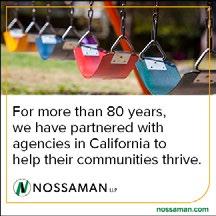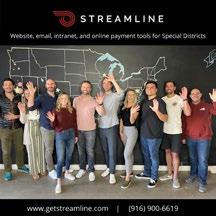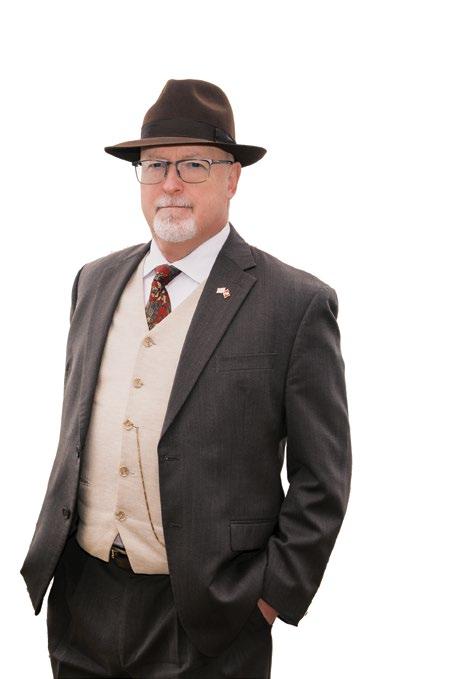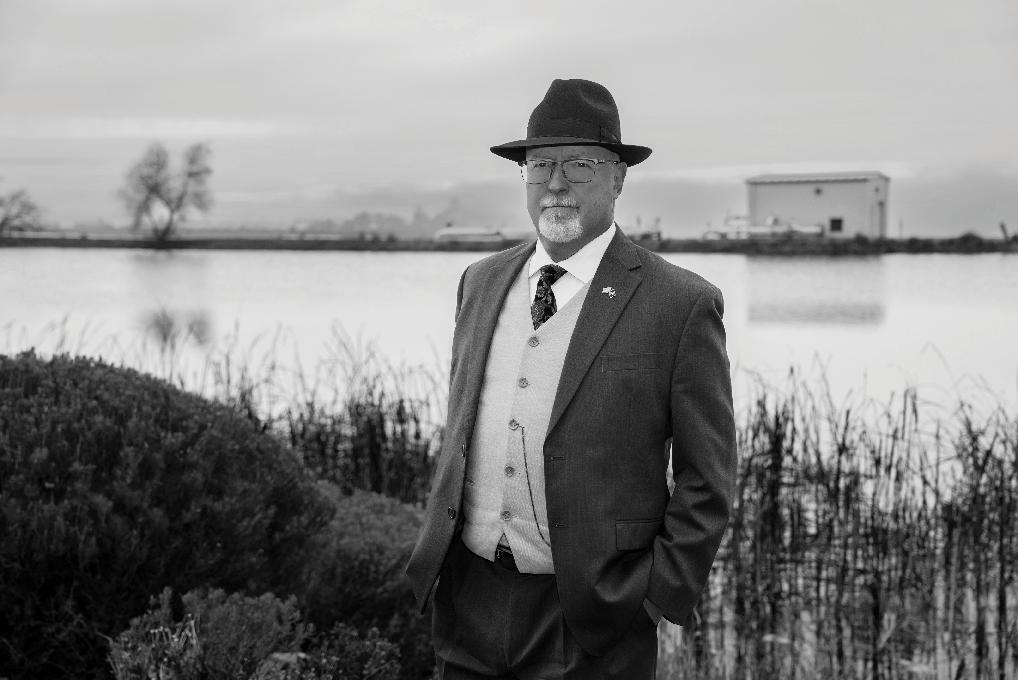PAGE 30

Interview
The Champion’s Mindset with Joe Theismann
Page 15 Managing Risk What’s on Cal/OSHA’s Radar? Indoor Heat Illness Prevention
Page 33

PAGE 30

Interview
The Champion’s Mindset with Joe Theismann
Page 15 Managing Risk What’s on Cal/OSHA’s Radar? Indoor Heat Illness Prevention
Page 33
The California Special Districts Alliance is a collaborative partnership between the California Special Districts Association (CSDA), the CSDA Finance Corporation (CSDAFC), and the Special District Risk Management Authority (SDRMA). These three highly respected statewide organizations join forces to help special districts in California better serve their communities.

PETER KAMPA, CSDM, PRESIDENT, Groveland Community Services District
LORENZO RIOS, CSDM, VICE PRESIDENT, Clovis Veterans Memorial District
ANTONIO MARTINEZ, SECRETARY, Contra Costa Water District
DON BARTZ, CSDM, TREASURER, Phelan Pinon Hills Community Services District
ELAINE MAGNER, PAST PRESIDENT, Pleasant Valley Recreation and Park District
RYAN CLAUSNITZER, CSDM, Alameda County Mosquito Abatement District
SCOTT DUFFIELD, CSDM, Heritage Ranch Community Services District
VINCENT FERRANTE, Moss Landing Harbor District
JERRY L. GILMORE, Truckee Sanitary District
CURTIS JORRITSMA, Hilmar County Water District
JO MACKENZIE, Vista Irrigation District
NOELLE MATTOCK, El Dorado Hills Community Services District
GREG P. ORSINI, McKinleyville Community Services District
PATRICK OSTLY, North of River Sanitary District #1
FRED RYNESS, Burney Water District
ARLENE SCHAFER, Costa Mesa Sanitary District
KIMBERLEE SENEY, Gold Mountain Community Services District
KATHRYN SLATER-CARTER, San Mateo County Harbor District
NEIL MCCORMICK, Chief Executive Officer
MEGAN HEMMING, Chief Professional Development Officer
MUSTAFA HESSABI, Chief Counsel
KYLE PACKHAM, Chief Advocacy & External Affairs Officer
CASSANDRA STRAWN, Chief Member Services & Communications Officer
RICK WOOD, Chief Finance & Operations Officer
TOMICKO ABELLA, Member Services Representative
AARON AVERY, Director of State Legislative Affairs
ANNA CALLAHAN, Legislative Assistant
EMILY CHA, Database & Online Communities Specialist
MARCUS DETWILER, Legislative Representative
BRENT FARRAR, Design & Websites Manager
AUBREY GOHL, Member Services Representative
JOSE GUERRERO, Graphic Design/Video Specialist
COLLEEN HALEY, Public Affairs Field Coordinator
CASSIE HASKINS, Member Services Representative
LILIA M. HERNANDEZ, Associate Legislative Analyst
MORGAN LESKODY, Communications Specialist
MICHAEL MEYER, Senior Member Services Specialist
CHRIS NORDEN, Public Affairs Field Coordinator
RICHELLE NOROYAN, Public Affairs Field Coordinator
CHRIS PALMER, Senior Public Affairs Field Coordinator
AMBER PHELEN, Management Analyst
RACHAEL POPPINO, Professional Development Coordinator
OLIVIA ROBERTSON, Member Services Specialist
JENNIFER SMITH, Professional Development Coordinator
OPHELIA SZIGETI, Legislative Analyst
ANTHONY TANNEHILL, Legislative Representative
ERASMO VIVEROS, Public Affairs Field Coordinator
DANE WADLÉ, Senior Public Affairs Field Coordinator
KRISTIN WITHROW, Communications Specialist
SANDY SEIFERT-RAFFELSON, PRESIDENT, Herlong Public Utility District
ROBERT SWAN, VICE PRESIDENT, Groveland Community Services District
JESSE CLAYPOOL, SECRETARY,
Honey Lake Valley Resource Conservation District
ROBERT HOUSLEY, CSDM, Midway City Sanitary District
MIKE SCHEAFER, Costa Mesa Sanitary District
TIM UNRUH, CSDM, Kern County Mosquito & Vector Control District
THOMAS WRIGHT, Clovis Veterans Memorial District
MICHAEL KRONBETTER, Public Financial Management
DEREK BURKHALTER, Bickmore Actuarial
MICHAEL BLOSS, River City Bank
CHRIS WIEGMAN, GroupOne
ANN SIPRELLE, Best Best & Krieger, LLP
KARL SNEARER, Apex Insurance Agency
DOUG WOZNIAK, Alliant Insurance Services, Inc.
DEBBIE YOKOTA, CPCU, Acting CEO/CRO
MATT CLUTTERBUCK, CPA, MBA, Chief Financial Officer
WENDY TUCKER, AU, Underwriting/Program Manager
ALANA LITTLE, Health Benefits Manager
ENRIQUETA CASTRO, CSP, Risk Control Manager
ROBERTO LOZANO, Liability Claims Manager
ALLISON BATEMAN, PHR, HR/Office Manager
PETR KOVALCHUK, CPA, Finance Manager
DANNY PEÑA, SIP, WICCA, Workers’ Compensation Claims Manager
JASON THORN, Data Achitect
MARIA WILLIAMS, ARM, Member Services Manager
MARGARITO CRUZ, Senior Accountant
ERIC LUCERO, ARM, Senior Risk Control Specialist
GUILLERMO DE LA TORRE, Senior Risk Control Specialist
TERESA GUILLEN, Program Specialist II
MICHELLE BROWN, Health Benefits Specialist II
CANDICE RICHARDSON, Management Analyst
KEITH IKAMI, Liability Claims Examiner I
LISA SANDOVAL, Program Specialist I
LILLI VINN, Accounting Technician
MARTHA WARREN, SIP, WCCA, Senior WC Claims Examiner
TAMARA BAKKIE, SIP, WCCA, Senior WC Claims Examiner
JOHN PESHKOFF, SIP, WCCA, Senior WC Claims Examiner
MARIETTA HARRISON, SIP, WCCA, Future Medical Claims Specialist
CHER DARLING, WC Compensation Claims Assistant
Special District Risk Management Authority 1112 I Street, Suite 300 Sacramento, CA 95814 tel: 800.537.7790 www.sdrma.org
CSDAFC Board and Staff
OFFICERS
JO MACKENZIE, PRESIDENT, Vista Irrigation District
VINCE FERRANTE, VICE PRESIDENT, Moss Landing Harbor District
ARLENE SCHAFER, SECRETARY, Costa Mesa Sanitary District
GLEN LAZOF, TREASURER, Regional Government Services Authority
MEMBERS OF THE BOARD
ELAINE MAGNER, CSDM, DIRECTOR, Pleasant Valley Recreation and Park District
GREG ORSINI, DIRECTOR, McKinleyville Community Services District
RONALD COATS, DIRECTOR, East Valley Water District
CONSULTANTS
RICK BRANDIS, Brandis Tallman, a Division of Oppenheimer & Co. Inc.
JEFF LAND Brandis Tallman, a Division of Oppenheimer & Co. Inc.
STEFAN MORTON, Municipal Finance Corporation
WILLIAM MORTON, Municipal Finance Corporation
ALBERT REYES, Kutak Rock LLP
NICOLE TALLMAN, Brandis Tallman, a Division of Oppenheimer & Co. Inc.
STAFF
NEIL MCCORMICK, Chief Executive Officer
DAVID MCMURCHIE, Legal Counsel
MICHAEL MEYER, Senior Member Services Specialist
AMBER PHELEN, Management Analyst
RICK WOOD, Chief Finance & Operations Officer
CSDA Finance Corporation 1112 I Street, Suite 200, Sacramento, CA 95814 tel: 877.924.2732 www.csdafinance.net
For editorial or advertising inquiries: Phone - 877.924.2732 Email - membership@csda.net
California Special Districts Association 1112 I Street, Suite 200 Sacramento, CA 95814
toll-free: 877.924.2732 www.csda.net
Let’s get to know the
Rachel Robbins Vice President Deposit Portfolio Manager
Jerry
Legg Senior Vice President Director of Public Sector Banking

What are you most excited about offering your clients as a team?
Jerry: We provide the knowledge, experience and services that districts need and deserve. We are like an extension of their staff.
Rachel: Ensuring my clients feel confident and valued in their banking relationship.
What are the challenges you see for public entities and how can CBC help?
Rachel: Fraud and Cybersecurity Risks. Public Sector organizations are frequent targets thus requiring strong security measures to protect financial data. At CBC, we care about your security. That’s why we offer Fraud Protection to help keep your account safe from unauthorized activity.
Jerry: The future looks uncertain for the public sector with potential cuts to federal funds and possible drops in tax revenues. We can save districts money on bank fees and have the ability to match the monthly LAIF rate on money market accounts for our relationship clients. We can help districts do more with less.

Rachel: You are not new to CBC. Tell us more. With over 5 years at CBC and 25+ years in the industry, I’m passionate about helping clients thrive by providing smart, customized banking solutions, and adding value in ways that help institutions grow and build lasting relationships!
Jerry: What has Rachel already brought to you and to your clients and prospects?
Working with Rachel is amazing. She delivers the best customer experience and makes banking easy for our clients.
Call us to see how we can help your district!
Jerry Legg
916.503.3356 | jlegg@bankcbc.com
Rachel Robbins
916.475.6267 | rrobbins@bankcbc.com


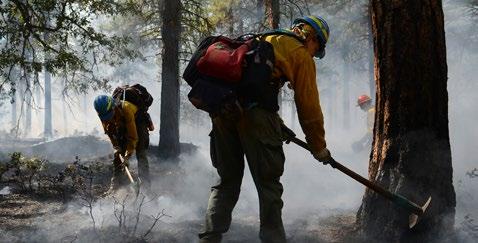
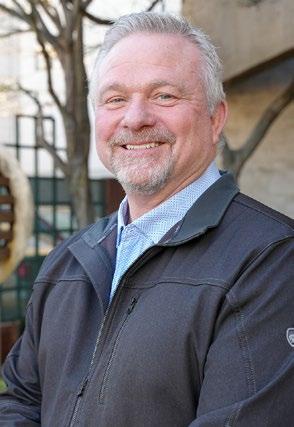
Peter Kampa, CSDM, CSDA President
As President of the California Special Districts Association Board, it is my privilege and pleasure to share a few reflections and aspirations with you.
For many years, I’ve had the honor of participating in CSDA events, attending conferences across California—from the towering Sierras to our breathtaking coastline. These gatherings have consistently been sources of inspiration, connection, and professional growth. They remind us that the heart of special districts lies in our commitment to public service, continual learning, and collaborative leadership.
This year, I’m particularly excited to attend our North State conferences. We’ll kick off with the General Manager Leadership Summit in Olympic Valley near Palisades Tahoe—a beautiful setting that reminds us of the freedom and independence we celebrate around the 4th of July. Then, we’ll head to the coast in August for our Annual Conference & Exhibitor Showcase in Monterey, a perfect chance to cool off, connect with peers, and immerse ourselves in ideas that drive progress.
Later in the fall, we’ll meet again in Santa Rosa, where Board Secretaries and Clerks will refine the vital skills that keep our districts running efficiently and transparently. And for our board members— new and experienced alike—the Special District Leadership Academy will be offering two more opportunities this year, in Redding and Monterey. These events are more than just conferences—they’re investments in leadership, governance, and service.
If you’ve never attended a CSDA event, now is the time to take that first step! With a range of options tailored to different roles and responsibilities (and scholarships available through the Special District Leadership Foundation) every district, regardless of size or budget, can benefit.
Beyond the conferences, I urge you to stay engaged with CSDA’s legislative and advocacy work. The issues we face, like evolving Brown Act requirements and the Advanced Clean Fleet regulations, have real impacts on our operations. Thankfully, CSDA is working tirelessly on our behalf and making it easy to stay informed. Be sure to read the weekly CSDA eNews, where updates and calls to action help us remain responsive and resilient.
I thank you for your continued membership, your leadership in your communities, and the friendships we build along the way. I hope to see many of you—whether in the mountains or by the sea—as we continue to grow, serve, and succeed together.
With gratitude and determination,
General managers and emerging leaders come together at our General Manager Leadership Summit, June 29 – July 1 in Olympic Valley, to gain insight, make connections and hone their skills. Tailored education specifically to your role, choose from sessions designed to keep you current on governance best practices, state laws, human resources, operations, pensions, budgeting, district policies and procedures, risk management, and more!
You won’t want to miss this year’s two dynamic keynotes. Jon Petz, Hall of Fame Inspirational Speaker, will kick off our general session with #Hashtag Worthy Leadership, sharing the kind of magic and meaning you can create for individuals and entire teams by adding simple moments
of significance. Tuesday’s keynote, Beth Z, Your Nerdy Best Friend, will talk about The Seven Things Your District Should be Doing with AI.
Plus, we provide plenty of interactive networking opportunities! New this year – join us for our Wine and Welcome Reception on Sunday and our Red, White, and BREWS Reception Monday.
You will return to your district with new enthusiasm and knowledge, ready to take your board relationship, staff, and district to the next level.

Included in this issue! Unlock opportunities with the CSDA Buyers Guide, your ultimate resource for special district needs. Explore a comprehensive directory of CSDA Business Affiliates, serving as a year-round reference for essential products and services. In addition, our online Buyers Guide at csda.net features additional Bronze level business affiliates for expanded options and convenience. Whether in print or online, trust the CSDA Buyers Guide to streamline your purchasing decisions and propel your district forward.
The CSDA Board approved the formation of the Special Districts Association of San Gabriel Valley - the 27th CSDA Affiliated chapter! The purpose of chapter affiliations is to bring local special district leaders together to collaborate, learn, and network together with other representatives from state, regional and local entities regularly. The San Gabriel Valley chapter can look forward to more collaboration, access to regional training, and a strengthened regional voice to elevate community awareness.
Special thanks to the chapter’s first board members: President Jody Roberto from Three Valleys Municipal Water District, Vice-President Nikki Winslow from Altadena Library District, Secretary Evelyn Reyes from San Gabriel Valley Municipal Water District, Treasurer Jason Farned from San Gabriel Valley Mosquito & Vector Control District and Director-At-Large John Bellah from Rowland Water District.


1 – 3 Special districts in the San Gabriel Valley recognized Assembly Member Blanca Rubio (AD-48) as CSDA Legislator of the Year at an event featuring local leaders from throughout the region. Assembly Member Rubio was honored for her support of local service specialists responsible for providing water, sanitation, healthcare, fire protection, parks, open space, resource conservation, mosquito abatement, library, and other essential services and infrastructure to communities throughout California.
“Assembly Member Blanca Rubio has been a real champion for special districts,” stated CSDA CEO Neil McCormick. “We are so fortunate Assembly Member Blanca Rubio is dedicated to protecting and advancing special districts and the communities they serve. She understands that special districts provide crucial services for millions of Californians and can do so most efficiently and effectively when provided local flexibility.”
4 – 8 The CSDA Training center was in full swing in April with two well-attended workshops. Supervisory Skills for the Public Sector taught by Michael Grabow with CPS HR Consulting and Human Resources Boot Camp for Special Districts taught by Jack Hughes with Liebert Cassidy Whitmore. Both of these workshops count toward the completion of the Essential Leadership Skills Certificate program offered by the Special District Leadership Foundation.
9 – 11 United States Representative Ami Bera, serving California’s 6th Congressional District, visited the offices of CSDA to meet with leaders from three special districts in the Sacramento area. The Congressman also took a few minutes to address the CSDA Board of Directors to offer a message of encouragement and optimism for the future.

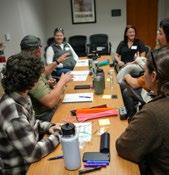

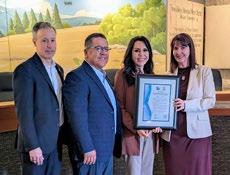

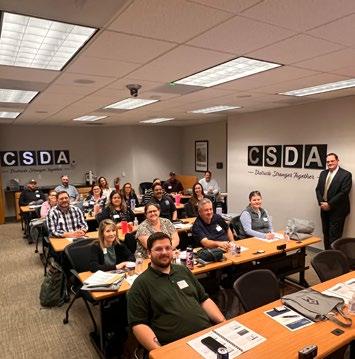
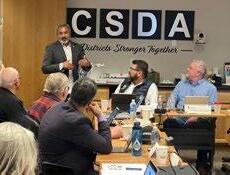


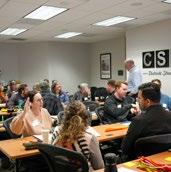
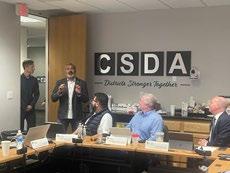
General Manager Leadership Summit
June 29 – July 1, 2025, Olympic Valley (Lake Tahoe Area)
CSDA Annual Conference & Exhibitor Showcase
August 25 - 28, 2025, Monterey
Special District Leadership Academy (North)
October 5 - 8, 2025, Redding
Board Secretary/Clerk Conference
October 27 - 29, 2025, Sonoma County
Special District Leadership Academy (Coastal)
November 16 – 19, 2025, Seaside (Monterey Area)
Pre-GM Summit Workshop: So, You Want to Be a General Manager?
June 29, Olympic Valley
Pre-GM Summit Workshop: A Double Dose of Executive Skills: Executing on Strategic Planning & Winning
June 29, Olympic Valley
Pre-Annual Conference Workshop:
SDLA Governance Foundations
August 25, Monterey
Pre-Annual Conference Workshop: So, You Want to Be a GM?
August 25, Monterey

To view more details and to register for conferences, events, workshops or webinars go to the CSDA Events Page https://qrco.de/bddc8t
Maximize Your Membership: Resources for Board Secretaries/Clerks
June 9
Webinar: Mastering Good Governance for a Better District
June 10
Webinar: Developing and Updating Comprehensive Emergency Operations Plans for Special Districts
June 17
Webinar: Building Tomorrow: Mastering Capital Project Financing for Special Districts
July 22
Send articles or ideas to membership@ csda.net for consideration in the California Special Districts magazine, CSDA eNews, the CSDA website, or on our social media channels.


By Dmitry Semenov, Principal, Ridgeline Municipal Strategies, LLC
When new development comes to town, it brings new people, new businesses, and new opportunities. It also brings new demand for parks, fire stations, and treatment plants. Who’s going to pay for it? If there is no plan, the burden unfairly falls on your existing residents.
That’s where impact fees can help. Designed to ensure that growth funds its own infrastructure needs, they are a critical funding tool for local governments. Yet, despite their importance, they’re often misunderstood. Here, we take on the three biggest myths about impact fees and suggest best practices to help you make the most of them.
Some agencies hesitate to implement impact fees because they worry about fairness or fear political backlash. But here’s the truth: California’s Mitigation Fee Act was specifically designed to empower local governments to fund essential public infrastructure. Without impact fees, existing residents and ratepayers foot the bill for new development. And that’s not fair.
• Educate Your Stakeholders. Clearly communicate that impact fees ensure growth pays its fair share and prevents service level declines.
• Develop a Strong Nexus Study. A good nexus study should properly calculate the fees and demonstrate that they are legal and equitable.
• Be Transparent. Public outreach and education campaigns help dispel fears and highlight the benefits of impact fees for the community.
Impact fees are like gardens, you can’t just plant flowers and walk away. Over time, development patterns change, costs rise, and facility needs evolve. If your impact fees aren’t updated regularly, you’ll soon find that they no longer provide adequate funding. Tomorrow’s infrastructure can’t be built with yesterday’s dollars.
BEST PRACTICES:
Do Regular Reviews. The law requires nexus studies to be updated every eight years, but best practice is to reassess them at least every five years—or sooner if major changes occur.
Monitor Construction Costs. Construction costs can change quickly. Ensuring fees reflect current costs and updating them for inflation will prevent revenue shortfalls.
Adjust for Land Use Changes. When development patterns shift, your impact fees should be adjusted accordingly.
Ignoring impact fee compliance is like skipping a dental exam—eventually, it’s going to get you in trouble. The law requires annual and five-year reports detailing fee revenues and expenditures, as well as on-going transparency practices. Ignoring compliance can lead to audits, legal challenges, and even forced fee refunds.
BEST PRACTICES:
Appoint an Impact Fee Champion. Designate a staff member or consultant to oversee impact fee compliance and reporting.
Create a Compliance Calendar. Monitoring important deadlines helps ensure that things don’t fall through the cracks.
Leverage Technology. Use a digital record management system for efficient fee collection, record-keeping, and reporting.
Impact fees are a powerful tool for critical infrastructure funding. By implementing a well-structured impact fee program, updating it regularly, and staying on top of compliance, your district can maximize revenues while ensuring fair and legally defensible allocation of costs.
To help you manage your fees better, we have designed FeeMaster, comprehensive software that helps you track, manage, and report impact fees. You can learn more about it at www.munifeemaster.com.
Growth is coming—make sure you have the right tools to keep up!





Questions Appear in CSDA Online Communities

Q: Michelle Harris, Administrative Executive, Board Secretary, Keyes Community Services District
We are having quite a few people reach out regarding the construction of ADU’s.I have been getting mixed information about the connection fees and if we can charge them or not. I was wondering if anyone else was dealing with this and if so does anyone have an ordinance they would mind sharing.
A: Thomas Brightbill, PE, Senior Engineer, Central Contra Costa Sanitary District
Check Government Code sections 66323 and 66324 (and check with your legal counsel.)
We often have people quote 66324(c)(1) and tell us that “impact fees” are not allowed for ADUs smaller than 750 square feet.The very next section, 66324(c)(2), clearly states that, ‘ “Impact fee” does not include any connection fee or capacity charge charged by a local agency, special district, or water corporation.’
Section 66324(e) allows water and wastewater connection or capacity fees for units “not described in paragraph (1) of subdivision (a) of Section 66323”
Paragraph (1) of subdivision (a) of Section 66323 describes “one [ADU] and one junior [ADU] per lot with a proposed or existing single-family dwelling” subject to several conditions including that the ADU is constructed within the space of the single-family dwelling.It also includes Junior ADUs.
Section 66324(e) requires that the water or wastewater Capacity Fee be “proportionate to the burden of the proposed accessory dwelling unit, based upon either its square feet or the number of its drainage fixture unit (DFU) values”
Engage with your peers and ask questions on CSDA’s Open Forum community!
https://www.csda.net/communities-home
CSDA Disclaimer: This section is not intended to be legal advice. Members should always seek legal counsel. The information contained here is for general reference purposes only.

The Truckee Sanitary District was pleased to announce the appointment of Sanna Schlosser as its new General Manager. She will assume her new role on March 3, 2025, succeeding Blake Tresan, who is retiring in May after a decade of dedicated service as the district’s General Manager. “We are incredibly fortunate to have found such a highly qualified candidate right here in our community. Sanna’s technical expertise and leadership experience make her an excellent fit for the district,” said TSD Vice President Catherine Hansford.

West Basin welcomed Wendy O’Kelly as their new Chief Financial Officer. An accomplished financial expert with decades of experience in both private and public sectors, Wendy brings extensive knowledge of strategic budget management and a proven record of delivering innovative financial solutions. “Wendy’s results-driven leadership and proven expertise will be beneficial to the continued progress and advancement of this agency,” said West Basin General Manager E.J. Caldwell. “Her focus on long-term financial sustainability, paired with dedication to public service, positions her to make an
impact through supporting the district’s growth and enhancing our ability to continue providing safe, reliable water to the communities we serve.”

Kevin Williams, who joined Calaveras County Water District as a Civil Engineer in 2019, and was promoted to Senior Civil Engineer in 2021, is now stepping into the lead engineer role. “Kevin’s promotion is a testament to his expertise, leadership, and dedication to our district,” said Michael Minkler, CCWD General Manager.

The Monterey Peninsula Water Management District announced the arrival of Mike McCullough as their new Assistant General Manager. McCullough, who has resided in the area for over 25 years, understands how important the management of local water resources is for the local communities. The district’s General Manager, Dave Stoldt, said “The district conducted a national search for a dedicated water professional, and the top candidate was literally next door at Monterey One Water. Mike has proven his knowledge of the complex local water issues, and he will bring
a new perspective and energy for our customers, staff, and Board.”


Santa Margarita Water District announced the addition of Lindsay Leahy as Deputy General Manager and Kristine Day as Assistant General Manager in April. Leahy has a background in engineering and a passion for operational excellence. Day will oversee daily operations, managing the team and ensuring customer satisfaction.

Dan Lewis was recently promoted to Director of Utilities at Tahoe City Public Utility District (TCPUD). Lewis first joined TCPUD in 1996 and has made outstanding contributions to the district throughout his tenure. Lewis has served the last 14 years as Utilities Superintendent, most recently serving as the Interim Director of Utilities for the past four months. His deep passion for public service, TCPUD’s Core Values, the Tahoe City community, and his fellow teammates will continue to serve the district well into the future.




By Kristin Withrow, Communications Specialist, CSDA



In August, CSDA is pleased to announce that the keynote speaker for our Annual Conference & Exhibitor Showcase in Monterey will be celebrated football icon and Super Bowl Champion Joe Theismann. He began his NFL career in 1974 with the Washington Redskins (now Washington Commanders), becoming their starting quarterback in 1978 and setting franchise records before suffering a traumatic leg injury that ultimately ended his career on the field.
How does this relate to special districts, and why did we select him as our keynote at our biggest event of the year? Joe Theismann has learned a few things about powering through adversity. He has reinvented himself several times over, from broadcast journalist to entrepreneur to motivational speaker, and he will undoubtedly turn conference attendees into cheering fans by the time he is through.
Special district leadership teams are regularly reinventing themselves and pivoting in response to external factors. Board members come and go, staff leadership changes can impact district culture, political winds shift and threaten
(or enhance) revenue streams – each time a significant force impacts a district, the entire team must shift in response. You never know when the “blitz” is coming, but you better have a plan when it does.
When Theismann suits up as a motivational speaker, he delivers a powerful message introducing concepts of personal responsibility, defining yourself and knowing your mission. “I’ve always believed that mental toughness is the key to surviving in life,” said Theismann. “You need to be strong foundationally to be able to grow from there.”
The structure and function of a sports team has overlapping trends in the world of business. A board of directors is comprised of individuals who must understand their personal motivations and values to ensure they fit into the team they’ve joined.
In the NFL, team structures have a hierarchy of responsibilities from owner to manager to a variety of specialized coaches, just like the structure of the relationship between the board of directors, general manager and staff. Learning to work together as a team is critical to the success of the mission. It’s important that
everyone shows up ready to work hard, fulfill their role, and share their energy with the team. “Attitude precedes everything we do,” said Theismann.
In addition to a firm foundation, goal setting is critical to success in business and life. In sports, plays are documented, studied and practiced. In business, goals need to be documented as well. From budgets to personal objectives, it’s important to take the time to put goals into formal, written documentation. Taking the time to conceptualize the goal and turn it into words on a page that the team can agree upon, and forming actionable steps to achieve results, brings it into existence far greater than staff meetings or sideline conversations.
“If things aren’t going the way you want, you have to take a step back and change, which is a challenge,” said Theismann. “If your action isn’t resulting in attaining the goal, you have to change the approach.”


Lastly, Theismann coaches, in business one of the great lessons passed from generation to generation remains true: “It’s never what you say to someone, it’s how you say it.” In teamwork, it is critical to work together in ways that continually motivate yourself and each other.
Theismann will bring big game energy to rally the crowd and leave the room motivated and ready to return home with a champion’s mentality to tackle special district challenges.
The CSDA Annual Conference & Exhibitor Showcase will take place August 25-28 in Monterey. It is the must-attend event for special district leaders across California! With a densely packed agenda, this conference offers unparalleled opportunities to connect with peers and experts and learn about new tools and trends.








CSDA’s mobile app, CSDA - The Hub, provides easy access to member benefits like online communities, newsfeeds with specialized content, and the power to organize your conference preferences so you never miss a session! It’s conference season, so if you are attending events like the upcoming General Manager Leadership Summit or the Annual Conference & Exhibitor Showcase, you will want to get to know The Hub!
• In the Apple or Google Play Store, search for “CSDAThe Hub”
• Click download/Install
• Click Open
• Once in the app, log in with your csda.net login username and password.
• To find a conference:
• For iPhone users, click the Events (calendar icon) on the bottom of the home screen.
• For Android users, click the hamburger / menu button at the top left, then click “Events”
Search using the name of the conference you are registered for.
Remember to turn on notifications so you don’t miss important event updates!
• View general hotel info including the hotel map, parking, and Wi-Fi
• View schedule, including speakers, sponsors, and handouts
• Add agenda items to your personal schedule
• Download handouts to your device
• Learn more about this year’s line-up of exhibitors
By Kristin Withrow, Communications Specialist, CSDA


Social media offers districts, large and small, the opportunity to craft stories that drive public perception. By using social platforms to share positive news about your district, you drive engagement and control the narrative told about your agency. Whether it is sharing news of new projects, highlighting key aspects of your service offering, sharing funding wins like receiving a grant, or creating a photo album of your latest community event, you should be the storyteller that drives public sentiment.
The Districts Make the Difference public awareness campaign, first developed by CSDA and then expanded nationally under our partnership with the National Special Districts Association, amplifies positive special district stories across the country.
This spring, we included a story from the North Tahoe Fire Protection District that we received through a press release issued by the district. It highlighted their snowmobile team’s ability to enhance their emergency response in backcountry terrain. We shared it to our national platforms, Facebook, Instagram, LinkedIn and X to give the story more
prominence and allow the public to realize special districts can include primary services, and extraordinary ones!
We invite all California special districts to engage with us on social media by liking us at @LocalDistricts. When you share your stories, tag us in your posts and we can engage with your posts, share them on our pages and boost your visibility!


The Special District Leadership Academy (SDLA) explores the essential partnership between board members and general managers to establish and carry out the mission of special districts. One element of the curriculum dives into the efficiency achieved with Unity of Purpose in High Functioning Boards.
It is important for individual directors to recognize that the function of the board is tied to their ability to act in unison. While individuals may pledge to fix problems or make changes, once they are a member on the board, they must work together to make progress on goals.
At the same time, unity of purpose does not mean uniformity or forced agreement. Unity is a spirit of shared commitment to work together in service to the public. It involves all members working toward the same purpose, mission and goal with a ‘we are one’ mindset. That is not the same as uniformity, which requires each member to believe and practice the same things and ignores individuality.
For effective governance teams to succeed, they need to identify and appeal to shared values and perspectives and interact with a spirit of teamwork and solutionbuilding. Obtaining consensus is achieved by starting with
high level issues and working through the details with a goal of merging perspectives along lines of agreement. It’s important to gather information and ensure all perspectives are represented to reflect the district’s needs and goals rather than those of any individual.
This year, the Special District Leadership Academy was offered in the Southern network in April in the Palm Springs area, and will be in the Northern network in October in Redding, and in the Coastal network in November in Monterey. SDLA offers curriculum-based training in four modules. Unity of Purpose is one element in Module #1 of the curriculum.
First-time attendees will take all four modules of curriculum; including Governance Foundations, Charting the Course/Setting Direction, The Board’s Role in Human Resources and The Board’s Role in Finance and Fiscal Accountability to be eligible to receive their Certificate in Special District Governance.
Returning attendees enjoy new sessions each year, exploring in-depth presentations from experts on governance, technology, financial and operational proficiencies, public meetings and more.



By Lexi Journey, Natural and Working Lands Program Manager, Rincon Consultants
Wildfires are prevalent in San Luis Obispo County. Within the last 75 years, wildfires have burned more than 300,000 acres (7,500 square miles) and today San Luis Obispo County averages more than 300 wildfires per year. Examples of large and destructive wildfires in San Luis Obispo County include the 1960 Weferling Fire (51,451 acres), 1950 Pilitas Fires (30,100 acres), 1985 Las Pilitas Fire (84,271 acres), the 1989 Chispa Fire (9,750 acres), the 1994 Highway 41 Fire (50,729 acres), 1996 Highway 58 Fire (106,969 acres and the largest fire in San Luis Obispo County’s recorded history), 1997 Logan Fire (49,4990 acres), and most recently the 2016 Chimney Fire (46,233 acres). All these fires burned within the wildland urban interface (WUI). These wildfires resulted in more than the loss of homes and infrastructure, they also resulted in the loss of lives. Since 1931, there have been fourteen deaths related to wildfires in San Luis Obispo County, all 14 were firefighters.
There are currently multiple efforts underway to develop plans related to evaluating and reducing wildfire risk and mitigating consequences in San Luis Obispo County. These plans have typically been based on jurisdictional or land use planning area boundaries. The intent is to guide hazardous fuels reduction, defensible space, home hardening, prescribed burning, ecological restoration, and more. Because they are based on artificial (and changeable) boundaries, these plans vary depending on each plan’s objectives. No single plan has been developed for the whole county based on an established, consistent format. This has resulted in decentralized project development that ignores the fact that wildfires frequently cross jurisdictional boundaries. While many of these efforts have been successful, there is value and efficiency gained in developing consistent planning areas throughout the county.
Therefore, through a California Climate Investment grant from CAL FIRE, the San Luis Obispo County Community Fire Safe Council (SLO FSC) has engaged a variety of partners to establish the San Luis Obispo County Fireshed Report and accompanying online Fireshed Dashboard.
The SLO FSC is managed by Dan Turner, retired fire chief and co-founder of the Cal Poly San Luis Obispo Wildland-Urban Interface Fire Institute who said, “While it is seemingly intuitive to utilize jurisdictional lines and land use planning boundaries for firesheds, the Fireshed approach visualizes the county in pre-colonial days when no artificial boundaries existed, only natural barriers to fire spread. This method recognizes the natural boundaries and microclimates that affect fire behavior.”
These firesheds are defined by areas of common geography and comprehensive wildfire behavior characteristic drivers (especially wind and ocean influence) where socioeconomic and ecological concerns regarding wildfire overlap. The methodology recognizes, but does not rely on, jurisdictional boundaries. It is instead based upon an understanding of historical fire spread patterns. Expert knowledge of historical wildfire behavior was used to identify the appropriate criteria to accurately distinguish each unit’s boundaries. This resulted in natural barriers to fire, such as mountain ranges, valleys, roads, ridgelines, and developed areas, to shape the natural borders between the different firesheds.
Examples of partners that were critical in the development of the firesheds included local fire departments, CAL FIRE, the San Luis Obispo County Office of Emergency Services, California Polytechnic State University - San Luis Obispo, and a former United States Forest Service biologist. These partners teamed with the SLO FSC to delineate firesheds using a diverse set of metrics and data to categorize wildfire risk, as well as risk of wildfire spreading. These factors include topography, elevation, vegetation, microclimates, soil types, hydrology, wildland urban
interface, wildfire risk assessment modeling, ignition history, roadways, fuels reduction, land ownership, ignition modeling, infrastructure, structure characterization, and evacuation routes. The resulting firesheds that were developed allow for the characterization of specific fire and community-related factors to promote consistency in the delineation of focused wildfire planning in San Luis Obispo County.
Through the assimilation of available Geographic Information Systems (GIS) data into a simple user interface, decision makers can use the Fireshed Report and Fireshed Dashboard to provide key information about dynamic factors affecting wildfire and management. There is increased long term value and efficiency in coordinating across planning areas for maximum collaboration, resource efficiency, data sharing, and analysis for use by stakeholder agencies to perform hazard and risk assessment, mitigation measures, ecological restoration, and emergency operations and recovery. This resource provides project planners and those seeking grant funding with a consistent platform on which to base their funding and permit applications and plans. Funding organizations and the public at large will benefit from this established standard with a better understanding of the larger strategic approach that a single project can relate to within this planning framework.
Consistency in wildfire planning across the county will improve collaboration, data sharing, data analysis, and education associated with the many wildfire planning and mitigation projects that are currently under way or being planned for in the future. A focused effort developed in concert with established standards will result in projects that complement one another and magnify benefits countywide. The Fireshed Report and accompanying online Fireshed Dashboard will result in a comprehensive source for reliable, consistent, and up-to-date data for project development and enable stakeholder agencies to plan for wildfires more effectively in San Luis Obispo County.




By Kristin Withrow, Communications Specialist, CSDA
Following a significant leadership change nearly five years ago, the new leadership team at Fresno Irrigation District (FID) undertook a staff polling project to gauge the staff’s expectations of leadership and their definition of success. A staff-wide survey was distributed, and employees were encouraged to provide honest feedback. As an agency that has been in operation for over 100 years, the leadership team felt it was important to establish a formal definition of what the district stood for in its operations, commitment to the community, and intention as an employer.
“Our fundamental 12 core values were born out of those survey results and employee responses. This led to the creation of CORE, as it is referred to. CORE is a dynamic initiative and has been developed in stages. CORE combines Organizational Development, Engagement, and Positive Culture Change, all interconnected by these core values. These core values and the formation of CORE were developed in-house, specifically tailored to enrich our
culture,” stated FID Human Resources Business Partner Donaday Chapman.
Accountability, Communication, Customer Service, Development, Efficiency, Flexibility, Honor, Integrity, Leadership, Safety, Teamwork and Technical Competencies became the defined, refined, and reinforced values embraced by the entire team at Fresno Irrigation District.
Each CORE value utilized staff comments in its build-out and support materials. It’s important to note, as stated by FID Assistant General Manager-Administration, September Singh, “These CORE values and definitions did not come from the top to be forced upon everyone. It was important to the new leadership to develop CORE in a thoughtful and democratic manner, supporting the voice of all staff and ensuring everyone’s values were reflected. In this way, we can proudly and collectively say WE are FID, and these are OUR values.”
continued ......>
Developing a variety of formats enabled the district to emphasize the core of their culture without imposing arduous learning modules on staff. It was important to the development team to be able to influence company culture while making the lessons approachable.
With 12 values built into learning modules, this allowed the district to roll out programming for one value each month. “Initially, there were multiple sessions of each core value training,” explained Chapman. “We launched with topical overviews of each value to provide a broad introduction of our definition of these values, so everyone started with the same foundation.”
Each introductory hourlong CORE session was pulled together into recorded presentations that new employees can view online that are used in onboarding and ongoing resources. In addition to the primary presentation, the district developed short-form “CORE Cues” to highlight elements of each value in ongoing mini-lessons in the form of short MP4 videos. These were created to keep CORE at “top of mind.”
opportunity for individuals to gain skills in leadership and other areas of professional development. The exploration of leadership includes sessions and discussions such as, critical thinking, personal branding, directing and delegating, business basics, and creating and delivering presentations.
Identifying these core values allows the district to continually and systematically reinforce the values, attitudes, and actions that are identified as central, or CORE, to the agency’s success. The program has been developed and implemented systematically over the course of five years to allow Chapman and the district the flexibility to respond to the needs of its employee population.
“These CORE values and definitions did not come from the top to be forced upon everyone. It was important to the new leadership to develop CORE in a thoughtful and democratic manner, supporting the voice of all staff and ensuring everyone’s values were reflected.
September Singh
Assistant General Manager-Administration, Fresno Irrigation District
The fourth phase of the rollout was dubbed “CORE More” and included the creation of a distinct banner for each core value, along with branded merchandise distributed during monthly team meetings. The banners incorporated comments from the original staff surveys, recognizing the entire FID team for their participation and contribution to the program. When each banner is rolled out, the corresponding “CORE Cue” short videos are reintroduced in a fun way that adds a gamification element with prizes for participants.
“Core Cubed” is the most recent phase of the CORE initiative and offers a 16-session, after-hours, voluntary
Since its inception, CORE has contributed to an 88% reduction in staff turnover, increased participation by staff in all areas, the creation of an engagement team, and 17% of the staff is enrolled in the 16-week after-hours professional development series.
CORE has not only redefined how Fresno Irrigation District operates internally but has also set a benchmark for fostering an engaged, value-driven workforce. By systematically embedding its 12 core values into every aspect of the organization, from onboarding to performance appraisals, to professional development, the district is cultivating a culture of accountability, collaboration, and continuous growth.
As FID moves forward, the program emphasizes the successful outcome when agencies invest in their people and take the time to align their actions with defined shared values at their foundation.



By Aleks R. Giragosian, PC Senior Counsel, Colantuono, Highsmith & Whatley
Special districts — especially utility districts like water districts, sanitary districts, and community services districts — have a vital role to play in development projects. Development cannot exist without a local government providing water, sewer, solid waste, and other essential services. But unlike counties and cities, special districts have no land use authority and cannot condition
development to comply with their requirements or manage the development process.
This article highlights a recent example from the Montecito Sanitary District (the District) to illustrate the challenges faced with development applications and how to overcome them.
Development can be divided into two phases and six milestones, as illustrated below:
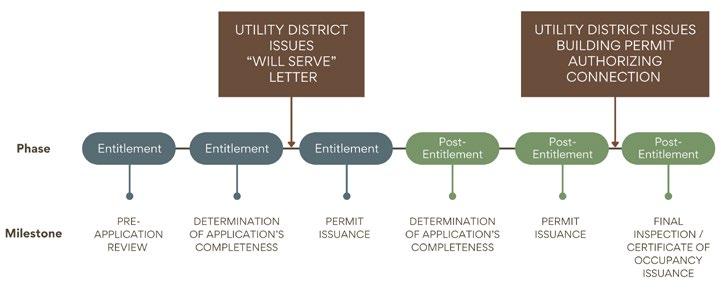
A utility district usually has two opportunities to comment on a project:
(a) before Milestone (2), when the utility district issues a “will serve” letter stating it has sufficient capacity to serve the development project, and (b) before Milestone (4), in the form of a building permit authorizing connection to the utility district’s infrastructure.
Montecito is an unincorporated community in Santa Barbara County. A Montecito resident must apply to the County planning department for an entitlement permit, and will be directed to the District to obtain a “Sewer Service Availability” letter (the District’s version of a “will serve letter”). When a resident is ready to apply for a post-entitlement permit, the County building and safety department will direct the resident to the District to obtain a “certification letter” (the District’s version of a building permit).
An applicant’s submitted designs are often preliminary or incomplete — and sometimes no one informs the District. A development project’s design is usually an iterative process during which an applicant submits multiple drafts to the relevant governmental bodies before a final design is approved. If the District is consulted early in the process, it might submit a set of comments and a will serve letter based on an initial design, only to learn during the postentitlement phase that the design was materially different than what was initially approved. At that point, it is too late to submit a new round of design comments and the District might not be able to serve the project as proposed.
The will serve letter only conveys that the District has the capacity to serve the development project as known to the District. The District does not have the authority to impose conditions on the entitlement permit through the will serve letter process. That authority lies with the land use
agency, in this case Santa Barbara County. If the District’s requirements necessitate a change in design, it cannot impose those requirements through the will serve letter.
The County building and safety department may not always inform applicants in the post-entitlement process of the need to obtain a certification letter from the District. Instead, applicants are informed during final inspection or issuance of a certificate of occupancy, the final step in the process, often having spent a good deal of time and money already. The applicant is understandably frustrated when the District raises engineering concerns and suggests changes to designs to meet its requirements, even though the County already approved the plans.
After a series of meetings with County officials, each issue was addressed.
For Issue A, the County and District agreed to a future process to stamp all plans and consult with the other to ensure both were reviewing the same set of plans.
For Issue B, the County agreed to incorporate the District’s proposed conditions into the conditions of approval of entitlement permits.
For Issue C, the County committed to inform applicants early in the post-entitlement application process that they needed to obtain a certification letter from the District.
Drawing from the experience of the Montecito Sanitary District, other special districts should consider:
1. Meeting with local county or city planning officers to familiarize themselves with the entitlement and postentitlement process;
2. Agreeing on a process to provide feedback on a project when it makes the most sense to do so; and
3. Obtaining the county’s or city’s consent to include an agency’s conditions in the entitlement and postentitlement approvals.


By Kristin Withrow, Communications Specialist, CSDA
Central Contra Costa Sanitary District (Central San) provides sewer services to nearly half a million residents and over 15,000 businesses in the east San Francisco Bay Area. Every day, they collect and clean more than 35 million gallons of wastewater. Much of the collection process occurs underground, making it invisible to the community. Now, Central San has created a bicycle- and pedestrian-friendly way for the public to learn where the water flows.
For 21 miles, the Iron Horse Regional Trail follows one of Central San’s sewer lines from San Ramon all the way to their treatment plant in Martinez. For their “Go With the Flow” project, Central San developed an interactive story map and self-guided tour to help people discover the
wastewater infrastructure along the trail and learn more about what’s happening underground. The multimedia map features photos, a history of the Iron Horse Trail, and even audio clips of the sound of water flowing through the pipe.
The idea for the story map first arose during the pandemic, when Central San’s traditional treatment plant tours and community events had to be put on hold. “We wanted to provide our customers with an outdoor, socially distanced way to connect with our system from wherever they were,” explains Community Affairs Representative Ben Lavender, the project manager. “Go With the Flow lets people discover where their wastewater goes and learn more about the essential service Central San provides.”


“The work of wastewater collection and cleaning is largely out-of-sight, out-ofmind. These tours allow people to understand the scale of our operations, see the impressive trucks and machinery we use to inspect and clean our pipes, and meet the people who do this job day in and day out.”
Ben
Lavender Community Affairs Representative Central Contra Costa Sanitary District
Using ArcGIS mapping technology, the story map includes points of interest, rest areas, and access points along the trail. Central San’s maintenance access covers (or “manholes”) serve as landmarks along the route, helping people visualize the sewer line under their feet. By following the map, Central San’s customers can walk, bike, or run along the path of wastewater—tracing its journey from their home, school, or workplace all the way to the treatment plant.
In addition to the story map, Central San has launched free, guided bicycle tours that explore different sections of the Iron Horse Trail. These family-friendly tours offer participants a fun and educational way to discover the wastewater system within their own backyards. Although Central San markets the popular events as bike tours,
they are in fact collection system tours. “The work of wastewater collection and cleaning is largely out-of-sight, out-of-mind,” explains Ben. “These tours allow people to understand the scale of our operations, see the impressive trucks and machinery we use to inspect and clean our pipes, and meet the people who do this job day in and day out.”
Beyond enhancing public engagement in Central San’s service area, “Go With the Flow” has inspired similar projects by other special districts. This spring, the project was honored as “Community Engagement and Outreach Project of the Year” by the California Water Environment Association.
Learn more and explore the map at: centralsan.org/gowith-the-flow





As rain showers arrive, flowers begin to flourish, and parks come alive with activity, SDRMA is here to support you. From flood protection to spring maintenance safety tips, we are your reliable partner in ensuring your district remains safe, lively, and prepared for the season.
#SDRMACares for districts, allowing you to concentrate on nurturing our communities.
Maximizing Protection. Minimizing Risk.

Insurance coverage protection so your district can bloom
Customized risk control solutions that nurture growth and resilience
Safety education that cultivates a culture of awareness And so much more!
Scan the QR code below to discover more about our programs and offerings, designed to help your agency flourish.


Proudly serving California public agency special districts since 1982.
By Enriqueta Castro, CSP, Risk Control Manager, SDRMA
We’re almost a year in on the Indoor Heat Illness Prevention requirements CCR3396, and like the outdoor requirements, Cal/OSHA is committed to protecting workers from preventable heat related injuries and illnesses. The Regulation went into effect on July 24, 2024 and it applies to most indoor workspaces where the temperature equals or exceeds 82° Fahrenheit when employees are present. The following is a brief summary of the regulation.
An indoor workspace is defined as a space that has a ceiling or overhead covering and is enclosed along its entire perimeter by walls, doors, windows, dividers, or other physical barriers that restrict airflow, whether open or closed. Indoor workspaces may include, but are not limited to, warehouses, maintenance & machine shops, boiler rooms, metal work areas, kitchens, and other workspaces with indoor heat-generating equipment. All work areas that are not defined as indoor are considered outdoor and covered by the Outdoor Heat Illness Regulation CCR 3395.
· Places of employment where workers are teleworking that are not under the control of the district.
Incidental heat exposures where a worker is exposed to temperatures at or above 82°F and below 95°F for less than 15 minutes in any 60-minute period (some exceptions apply).
· Emergency operations directly involved in the protection of life or property. Prisons, local detention facilities, and juvenile facilities.
Employers must implement the requirements of the regulation when one or more of the following conditions exist to indoor workspaces:
· The temperature equals or exceeds 87 degrees Fahrenheit when workers are present.
· The heat index equals or exceeds 87 degrees Fahrenheit when workers are present.
· Workers wear clothing that restricts heat removal and the temperature equals or exceeds 82 degrees Fahrenheit.
· Workers work in a high radiant heat area and the temperature equals or exceeds 82 degrees Fahrenheit.
Requirements include:
Access to potable water that is fresh, suitably cool, and at no cost to employees.
· Access to at least one cool-down area. Procedures to assess and measure heat whenever the indoor temperature or heat index reaches 87° F when employees are present, or 82°F when workers wear protective clothing that restricts heat removal or work in high radiant heat areas.
· Emergency response procedures.
· Close observation procedures during acclimatization. Employee and supervisor training.
· Development of a written Indoor Heat Illness Prevention Plan. The Plan can be combined with the Outdoor Heat Illness Prevention Plan and both may be included in the district’s Injury & Illness Prevention Program or stand alone.
The regulation includes a wide range of potential conditions, scenarios, and requirements, based on specific operations. It’s critical to conduct a thorough review of the regulation when developing customized procedures. If you are a SDRMA member, your Risk Control Team is available to assist. In addition, the following resources are available through Cal/OSHA:
· Indoor Heat Illness FAQs (very informative!)
· Sample Heat Illness Prevention Plan – Combined Indoor & Outdoor
· Comparison of Indoor & Outdoor Heat Illness Requirements Other Indoor Heat Illness Publications
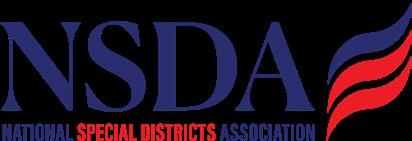
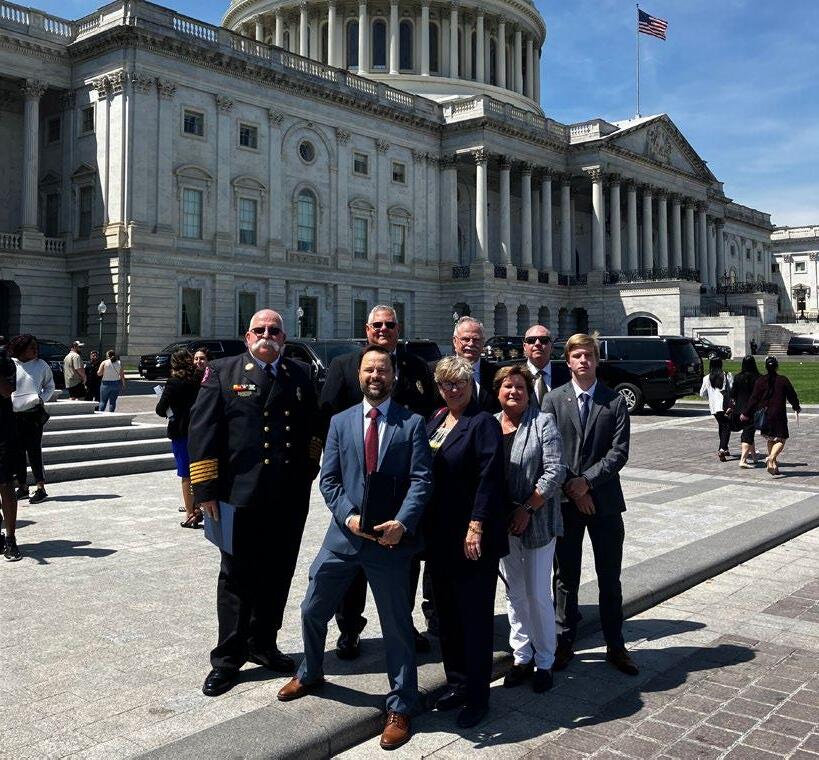
by: Kristin Withrow, Communications Specialist, CSDA
Last year, the Special District Grant Accessibility Act was passed by the U.S. House of Representatives in May and then introduced in the Senate by Senators Kyrsten Sinema and John Cornyn in July. The bill’s primary objective was to establish a first-ever, formal definition of “special district’ in federal law to ensure communities served by special districts were eligible for all appropriate forms of federal financial assistance. Unfortunately, the Senate did not act on the bill before it closed for the year in December. As primary supporters of the legislation, the National Special Districts Association
vowed to continue its efforts to establish one federally recognized definition of special district. Traction on this effort is beginning to take hold.
In April, Representative Pat Fallon (R-TX) and Brittany Pettersen (D-CO) introduced a bipartisan bill (H.R. 2766) to direct the White House Office of Management and Budget (OMB) to issue guidance to federal agencies requiring special districts to be recognized as local governments for purposes of ensuring that districts have access to all appropriate forms of federal financial assistance.
It should be noted that H.R. 2766 is identical to last year’s legislation that was overwhelmingly approved by the full House of Representatives. Only the name has changed: It is now known as the Special District Fairness and Accessibility Act.
Pursuant to H.R. 2766, federal agencies would have one year to implement OMB’s guidance and to conform any agency policy, principle, practice, procedure, or guideline relating to the administration of federal financial assistance programs. Implementation of the bill’s requirements would result in special districts being formally recognized as units of local government across the federal bureaucracy, thus ensuring that special districts are adequately included in federal-state-local planning processes and have access to all relevant funding streams and grant programs.
The Fallon-Pettersen bill has been referred to the House Oversight and Government Reform Committee. It is unclear when the legislation will be considered by the committee. In the upper chamber, Senators John Cornyn (R-TX) and Jeff Merkley (D-OR) are expected to introduce a companion version of the Special District Fairness and Accessibility Act.
The National Special District Association recognizes this as our primary legislative priority and will issue ongoing updates through the California Special District Association eNews and Advocacy News outlets.
The National Special Districts Association, of which CSDA is a founding member, has launched a discussion series designed to help special districts stay informed of funding opportunities. This exclusive, members-only discussion series brings experts in their field to provide current guidance in a rapidly changing political environment. CSDA members have access to content from the NSDA using access code CSDA7525.
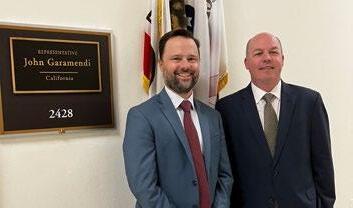

Districts Association to meet with Legislators.
Above Top: Kyle Packham, CSDA Chief Advocacy & Public Affairs Officer, and Neil McCormick, CSDA CEO, at the office of California Representative John Garamendi in Washington D.C.
Above Bottom: Left to right – Jake Bentham, Legislative Aide, Kyle Packham (CSDA), Neil McCormick (CSDA), Adrienne Epstein, Policy Advisor, outside the office of U.S. Senator Alex Padilla
• Disaster Response Recovery Resilience on Tuesday, June 24 at 11:00 a.m. PST
• Federal Advocacy on Tuesday, July 8 at 11:00 a.m. PST
• Fire Services Funding on Wednesday, September 10 at 11:00 a.m. PST





By Christine Martin, Director, Tripepi Smith
Many local governments struggle to recruit and retain employees. The National Employee Survey (NES) by Polco consistently reveals that local government employees rate their agencies poorly in areas such as:
• Managing low-performing employees
• Cross-department collaboration
• Responsiveness to important issues
• Competitive compensation
• Performance-based pay
Survey data also highlights work-life balance, morale and fair compensation as critical factors influencing employee retention. To build a high-performing team, leaders must create a workplace culture that inspires and engages employees. Here’s how local governments can attract and retain top talent:
Salary is a primary factor for jobseekers. Regularly review market trends to ensure pay remains competitive. Beyond base salary, clearly communicate the total compensation
package, including retirement benefits, healthcare and professional development opportunities. Many employees may not fully understand the long-term advantages of public sector benefits.
Public service provides a unique opportunity to make a tangible impact on the community. Highlight how each role contributes to the greater good, as workers often seek purpose-driven careers.
Counteract the perception that local government positions are static by demonstrating pathways for advancement. Promote internal mobility, mentorship programs and leadership training to show employees their long-term potential within the organization.
Use professional and engaging visuals across LinkedIn, Instagram and other social media platforms. Develop
recruitment videos and success stories that showcase the workplace culture, community impact and employee experiences.
Create a talent pipeline by collaborating with educational institutions. Offer internships, job shadowing programs and career fairs to introduce students to public sector careers early on.
First impressions matter. Onboarding should begin before the employee’s first day and extend throughout their first year. Consider sending a welcome letter from leadership upon hire, providing a welcome package with personal touches and assigning a mentor or ‘buddy’, to name a few.
Conduct employee surveys and follow up with concrete action plans. Understanding pain points and areas of success enables leadership to make meaningful improvements.
A successful team thrives on accountability. Conduct regular performance evaluations to provide constructive feedback, recognize achievements and address underperformance to maintain a high-performing workplace.
Employee appreciation is key to retention. Consider:
• An annual appreciation lunch celebrating milestones and achievements.
• Public recognition through newsletters, social media, or team meetings.
• A structured rewards program tied to performance and contributions.
Offer alternative work schedules, remote work options (where feasible) and up-to-date technology to improve efficiency and work-life balance.
Experiment with initiatives like “Bring Your Pet to Work” days, casual dress codes or new wellness programs. Employees appreciate an organization that is open to innovation and feedback.
Encourage continuous growth by offering access to: Professional conferences and leadership programs
· Webinars and online learning platforms
· Cross-training opportunities to expand skill sets Tuition reimbursement or certification programs
Foster a connected workplace with initiatives such as:
• Wellness activities (walking groups, sports clubs)
• Brown bag lunch discussions on diverse topics (home improvement, financial planning, travel, etc.)
• Financial wellness resources, including retirement education and savings plans.
• Employee resource groups and book clubs
• Annual employee fairs focused on safety, appreciation and professional development
Providing sabbaticals or additional paid leave helps employees recharge while also stress-testing the organizational structure. Temporary vacancies offer aspiring employees leadership opportunities.
Exit interviews should not be a formality but a strategic tool. Summarize findings for the executive team and commit to addressing recurring issues to improve retention.
By prioritizing employee satisfaction, professional development and work-life balance, local governments can build a thriving workforce. Investing in employees strengthens organizational culture, enhances service delivery and ensures long-term success in meeting community needs. A proactive approach to retention and recruitment will create a more engaged, motivated and effective team dedicated to delivering excellent public service.

By Sara Parral, Communication Specialist, West Valley Solid Waste Management Authority
Diverting food scraps from landfills is a critical step in reducing waste and lowering greenhouse gas emissions. Organic waste that ends up in landfills decomposes and releases methane, a potent greenhouse gas that significantly contributes to climate change. While many communities have adopted food scraps recycling programs, getting residents, especially those in multi-family housing, to actively participate remains a challenge. Factors such as lack of awareness or confusion, inconvenience, and concerns about odors and pests can deter residents from taking part.
The multi-family sector has historically faced lower diversion rates compared to single-family homes, making it a key area for targeted intervention. Complex living arrangements, shared waste disposal systems,
and inconsistent access to recycling education further contribute to low participation rates. Recognizing these challenges, the West Valley Solid Waste Management Authority (Authority) and the City of Sunnyvale (Sunnyvale), have launched separate pilot programs focused specifically on multi-family households. Each program is testing a different approach to engaging
residents in food scraps recycling, with the goal of identifying best practices that can be applied on a larger scale to improve overall program success.
The Authority is embracing technology-driven solutions to eliminate common barriers to participation. Many residents cite concerns about mess, odors, and limited space as major deterrents to participation. To tackle these challenges, the Authority’s pilot program is testing Mill Industries’ in-home kitchen dehydrators, which offer a clean, convenient, and odor-free way to handle food scraps. These high-tech devices transform food waste into a dry, lightweight material that is easy to store and collect, directly addressing the concerns that often prevent residents from participating. Additionally, the technology allows users to track their waste reduction progress in real time, providing instant feedback and reinforcing positive behaviors. The hope is that by integrating technology into the process, food scraps diversion will become a seamless and rewarding habit for participants.
Meanwhile, Sunnyvale is taking a community-driven approach, focusing on direct outreach, education, and behavioral change strategies to increase participation. Many multi-family residents face common barriers to food scraps recycling, including lack of awareness, confusion about proper sorting, and uncertainty about the benefits of participation. To address these challenges, Sunnyvale

is prioritizing effective communication, engagement, and motivation rather than specialized technology. The city is utilizing tools such as social norms, personal commitments, and prompts to encourage residents to take part, recognizing that when people see their neighbors participating, they are more likely to do the same. By testing these social engagement strategies, Sunnyvale aims to determine how education and direct interaction can overcome barriers, drive behavior change, and boost participation rates.
Both pilot programs are incorporating visual waste audits to measure their impact and identify the most effective strategies for increasing food scraps recycling in multi-family communities. These audits analyze waste composition in each material stream before and after implementation, assessing factors such as food scraps contamination, landfill waste reduction, and the volume and weight of recycled food scraps. By gathering this data, the Authority and Sunnyvale can determine which methods drive higher participation rates, increased food scraps recycling, and improve overall program efficiency. The findings from these pilots will not only help shape future food scraps diversion programs but also provide data-driven recommendations that enable cities to invest in strategies that have been proven to be effective.
While the pilots are still ongoing, the results could revolutionize food scraps recycling and offer valuable lessons for other communities facing similar challenges. Which approach will prove most effective?
Attendees at the 2025 CSDA Annual Conference & Exhibitor Showcase in Monterey can hear more about this story in our breakout session:
Power in Community-Based Social Marketing: Organics Recycling in Multi-Family Communities
Tuesday, August 26 at 11:00 a.m.


By Jessica Self, General Manager, Union Public Utility District and Dean Atyia, Partner, Best Best & Krieger
Nestled in the heart of Murphys, California, Union Public Utility District (UPUD) sits on Main Street, surrounded by wineries, restaurants, and art galleries. Many families have lived here for generations, contributing to the town’s rich heritage. Originally formed by locals as the Calaveras Water Users Association in the 1920s, UPUD is still committed to providing reliable water service to the community.
The office feels like a scene from a Hallmark moviewelcoming, and familiar. Staff greet visitors by name, and even a cat named Mister often stops by to say hello. Yet litigation loomed when new rates were adopted in 2022.
The process was contentious as multigenerational irrigators faced steep increases. By July 2023, tensions were boiling when UPUD received a class action lawsuit and a citizen initiative to repeal the new rates.
Newly hired General Manager Jessica Self quickly took action, retaining counsel from the law firm Best Best &
Krieger. Simultaneously, Self focused on rebuilding trust in the community. She met with concerned customers, listened, and sought solutions. At board meetings, she educated the public on capital improvement projects, Proposition 218, strict drinking water regulatory requirements, and the necessity of rate increases. By spring 2024, good news arrived when the citizen initiative was withdrawn after the district pledged to conduct another rate study as a sign of good faith and commitment to transparency. UPUD hosted focused workshops, delivered clear and engaging public notifications, and kept its doors open for community discussions.
In December 2024, the district held a public hearing on the updated rate study. Only nine formal protests were received, none from irrigation customers. UPUD had successfully navigated one of its biggest challenges while reinforcing trust in its leadership.
UPUD’s example is a textbook study on the benefits of community engagement in avoiding protracted legal battles and reaching an economical and beneficial resolution when adopting increased water rates. However, even if nine out of ten citizens come to accept necessary rate increases, one holdout can initiate proceedings that require an agency to incur legal costs and defend rates through formal litigation.
Agencies should consider the framework of a legal defense, even in tandem with community engagement, to prepare for any contingency. We encourage consideration and discussion of these issues as early as possible. There are four primary tools at any agency’s disposal.
• The Rate Study: The clarity of a Rate Study (or Cost of Service Analysis) serves as the primary point of evidence in any legal defense to justify rates under Proposition 218. The Rate Study must be thorough, data-driven, and conducted by an expert. Engage in this preparation in advance of any rate adoption to provide significant time to review for accuracy.
• Public Workshops: Public workshopping allows for a controlled environment to present information, answer questions, and make crucial face to face connections with the community.
• AB 2257: California law requires a litigant to first exhaust administrative remedies prior to suing a public
agency. However, what constitutes an “administrative remedy” in the context of Proposition 218 has not always been clear. Last year, AB 2557 provided clarity by establishing an independent administrative remedy that a potential plaintiff must exhaust prior to any Proposition 218 litigation. It also serves to limit the evidentiary burden in any future litigation. Through this process, an agency has an opportunity to cure any legitimate challenges to proposed rates, as well as a defense to litigation if a potential litigant fails to comply with exhaustion procedures.
• Government Code Section 53759 and Validation: If community engagement does not resolve all ratepayer concerns, and an agency expects a legal challenge, Government Code section 53759 allows an agency to proactively seek judicial validation of any rate increase. The primary benefit is a shortened timeline for resolution, which can offset the protracted uncertainty inherent in some litigation. Section 53759 also imposes requirements on any plaintiff, such that failure to comply with the statute can serve as a bar to challenge.
In engaging with the community, we provide guidance and feedback to assist in addressing specific questions, and evaluate issues to determine if further action is necessary. The results achieved by UPUD required significant effort and commitment from agency leaders and staff and ultimately strengthened ties in the community.
For 37 years, CSDA Finance Corporation has been providing timely, low-cost financing solutions to districts throughout California. So far this year, CSDAFC has facilitated financing for a wide range of projects and purchases, totaling over $89 million.

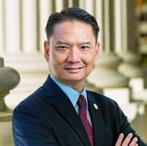
Elected in 2022, Assemblymember Tri Ta serves California’s 70th Assembly District.Prior to being elevated to state office, Assemblymember Ta held the distinction of being the first Vietnamese American to hold the office of city Mayor in the United States, serving the city of Westminster.
CSDA: How would you advise special districts who want to build on relationships with legislators and staff to best advocate for their district and community?
Asm. Ta: I would recommend that special districts reach out and build relationships early with your legislators and their staff. I always enjoy joining events put on by my local special districts, like my sanitation district’s Annual Open House or a holiday tree lighting by my local community services district. Also, if the member is less familiar with special districts and their operations, a tour is a great way to share the amazing work of special districts in a more casual setting.
CSDA: How has your role as Vice-Chair of the Assembly Local Government Committee helped you advocate for your constituents?
Asm. Ta: I was just appointed to this role in January, but when I was first elected to the Assembly I made it a priority to work with my local cities and agencies to advocate for their needs. Stepping into this role will further empower me to fight for my district. I am truly looking forward to connecting with local elected officials and staff from around California to be their voice in the Local Government Committee.
CSDA: What are your current and long-term policy priorities, particularly as they relate to the governance and operations of special districts and other local governments?
Asm. Ta: I am a big advocate for local control for special districts and municipalities. Overly burdensome mandates from Sacramento tie the hands of policymakers that want
to serve their local communities. As a former Mayor and water district board member, you can count on me to be a strong advocate for local control.
CSDA: What specific challenges exist for communities in Orange County that may not exist in other parts of the state?
Asm. Ta: For the most part, Orange County is generally built-out, so we don’t have a lot of the challenges that more rural communities may face. We are also a very diverse county. In fact, my district has Little Saigon, the largest population of Vietnamese living outside of Vietnam. We also have large Latino and Korean populations. With that comes challenges for governments to connect with and reach their constituencies.
Similar to other parts of our state, Orange County has faced drought and water management issues. As former Orange County Water District Director, I’m proud of the work OCWD performs for groundwater storage and the state-ofthe-art Groundwater Replenishment System to ensure that north Orange County has a reliable and safe water supply.
CSDA: Can you please share your highlights and biggest accomplishments during your Assembly terms?
Asm. Ta: My first term was very productive. I was able to secure $1M in state funding for a new park and accessible playground in Fountain Valley so children of all ages and abilities can play together in an inclusive space. I also worked with my local cities to author AB 1782, which was signed into law by the Governor. This bill gives cities more flexibility to use their RDA Successor Agency funds to contribute toward regional homeless shelters.
Additionally, I am proud to have authored AB 1805. This bill ensures that students learn about the historic Mendez v. Westminster case in the social science curriculum and how California was the first state to desegregate back in 1947. Sylvia Mendez is one of my heroes, and I look forward to continuing to work with her to share her story.


















Actuarial Retirement Consulting, LLC www.awenarc.com
Amazon Business www.csda.net/amazon-business
AllPaid www.AllPaid.com
California CAD Solutions (CALCAD) www.calcad.com
California CLASS www.californiaclass.com
CPS HR Consulting www.cpshr.us
Utility Cost Management, LLC www.utilitycostmanagement.com

CSDA Finance Corporation www.csdafinance.net
Enterprise Mobility www.enterprisemobility.com
GovDeals www.govdeals.com
Special District Risk Management Authority www.sdrma.org

Streamline www.getstreamline.com
Umpqua Bank www.umpquabank.com

VC3 www.vc3.com

Atkinson, Andelson, Loya, Ruud & Romo www.aalrr.com
Best Best & Krieger www.bbklaw.com
California Bank of Commerce www.californiabankofcommerce.com/




Tri Counties Bank www.tcbk.com
Five Star Bank www.fivestarbank.com
Liebert Cassidy Whitmore www.lcwlegal.com
Richards Watson Gershon www.rwglaw.com
In public service, financial accuracy is essential. For Shane McDonald and Brandi Perrone of Trinity County Waterworks District, finding a reliable actuarial partner was harder than expected. Their first choice—a wellknown firm—delivered delays and unexpectedly high costs.
Determined to do better, they turned to the California Special Districts Association (CSDA) website, where they found Molly McGhee of Actuarial Retirement Consulting (ARC). From the start, Molly’s professionalism and expertise stood out. Even before a contract was signed, she offered guidance and clarity, helping Shane and Brandi navigate their challenges.
Once on board, Molly delivered a comprehensive actuarial evaluation—on time and with transparent pricing. Her work impressed not only the district team but also their experienced auditor, who called her “the best actuary he’s ever worked with.”
Molly’s responsiveness, accuracy, and integrity made a lasting impression. Shane and Brandi quickly brought ARC on for ongoing support, confident they had found a true partner.
Their story is a reminder for other special districts: finding the right actuarial expert can ease the burden of financial evaluation and bring peace of mind. With professionals like Molly McGhee, districts can move forward with confidence and clarity.
Brown Armstrong Accountancy Corporation
www.bacpas.com
CalTRUST
www.caltrust.org
Centrica Business Solutions
www.centricabusinesssolutions.com
Cole Huber LLP www.colehuber.com
Complete Paperless Solutions www.cps247.com
Easeworks www.easeworks.com
Kosmont Financial Services
www.KosmontFinancial.com
National Demographics Corportaion (NDC) www.ndcresearch.com
NBS
www.nbsgov.com
Nossaman, LLP www.nossaman.com
Redwood Public Law, LLP www.redwoodpubliclaw.com
River City Bank www.rivercitybank.com
SiteLogiq www.sitelogiq.com
Slovak Baron Empey Murphy & Pinkney LLP www.sbemp.com
Tyler Technologies, Inc. www.tylertech.com
Witt O’Brien’s www.wittobriens.com







